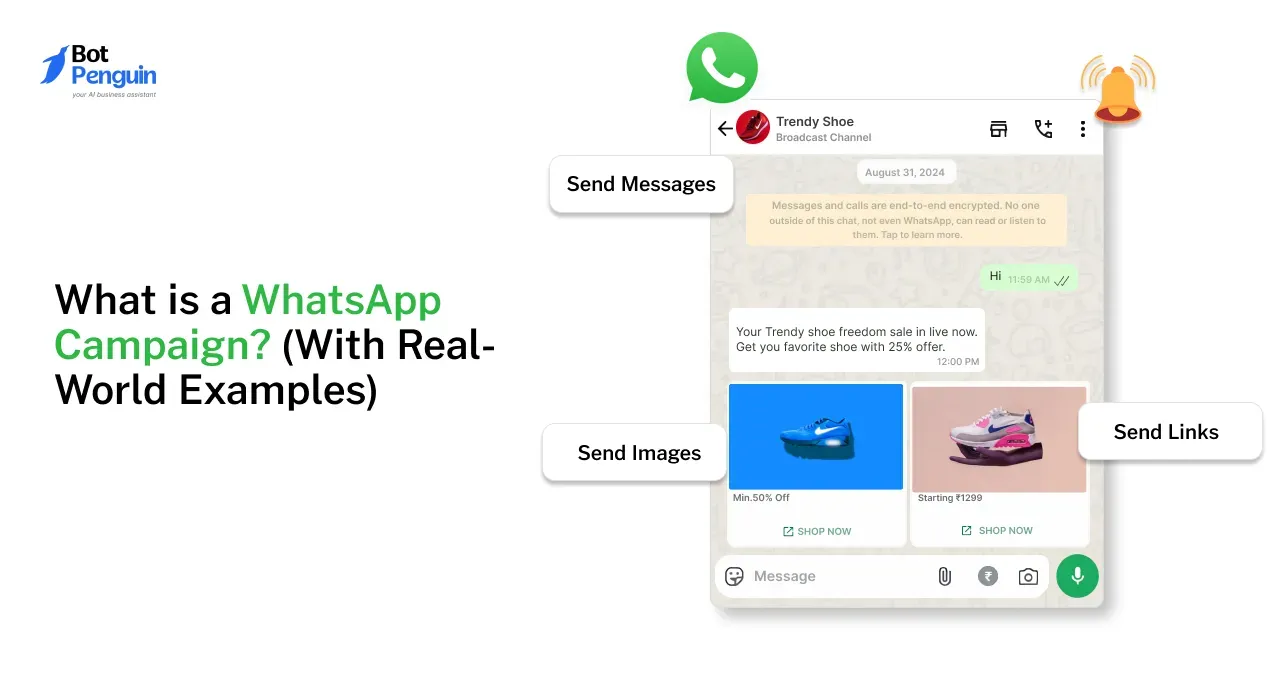Have you ever received an email customized for you that you couldn't stop opening?
Emails help your customers form an opinion about your business, and personalization drops that unique touch that will positively impact readers.
Personalization is the key to converting essential communication into a customized customer experience. It goes beyond simply saying hello while covering the area of understanding and complying with particular demands.
A special message created for your unique customers is essential to maintain long relationships. It also negotiates complex ways to increase open rates, sharply increase click-through rates, and raise the conversion bar.
Say goodbye to those annoying unsubscribe rates. Let's up your email game and add that personal touch!
Continue reading to learn more about personalization and its effect on email marketing metrics.
What is Personalization in Email Marketing?
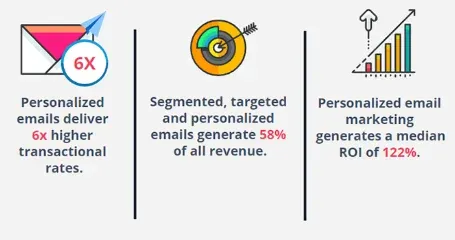
The main goal of personalization in email marketing is to give your subscribers a customized experience. Not only should you greet them by name, but you should also provide information that speaks to their needs.
You send emails that seem as though they were custom-made for them by delving deeper into their preferences through categorization and personal data. By personalizing your emails just for them, you can help your readers feel like more than simply a name or email address. That's what it means to make them feel appreciated, respected, and completely understood.
Different Types of Personalization Techniques for Email Marketing
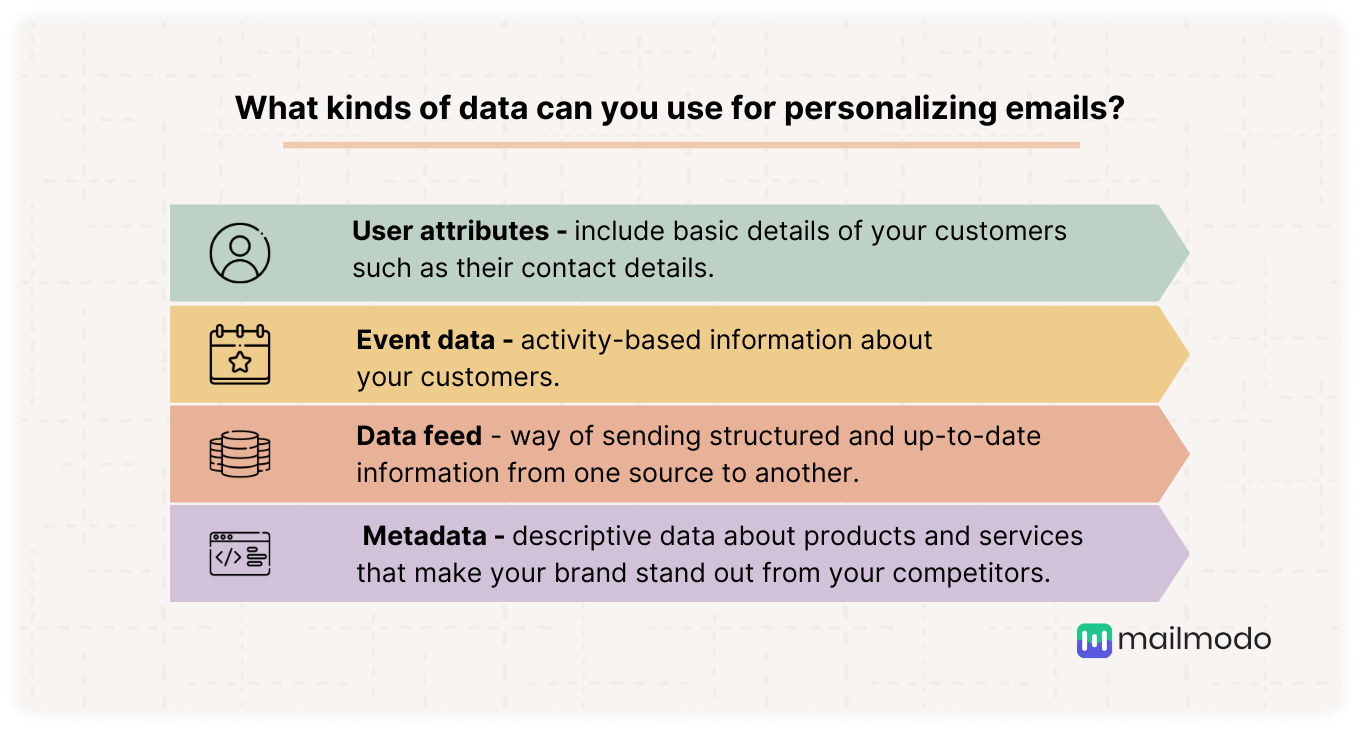
You may customize your email marketing campaigns in several ways and take your marketing from ordinary to extraordinary. Here are some innovative ideas for creating emails that stand out and captivate your audience. The following strategies will enable you to transform your emails.
- Personalized Subject Lines
Creating subject lines that speak to the intended audience specifically can boost open rates considerably. A topic line that includes their name, location, or other relevant details attracts attention and establishes a personal connection.
- Dynamic Content
You can personalize email content with flexible material according to user preferences, previous behavior, or demographics. You may increase engagement and conversion rates significantly by presenting suitable data to the appropriate audience.
- Behavior-Triggered Emails
This indicates your attention to information when you set up automatic emails depending on user behavior, such as post-purchase follow-ups or reminders for abandoned carts. This increases conversion rates and encourages client loyalty.
- Segmentation
Segmenting your email list based on demographic information, purchase history, or engagement level allows you to send targeted messages to specific groups. By delivering content that matches their interests, you'll improve engagement and campaign success.
The Benefits of Personalization in Email Marketing
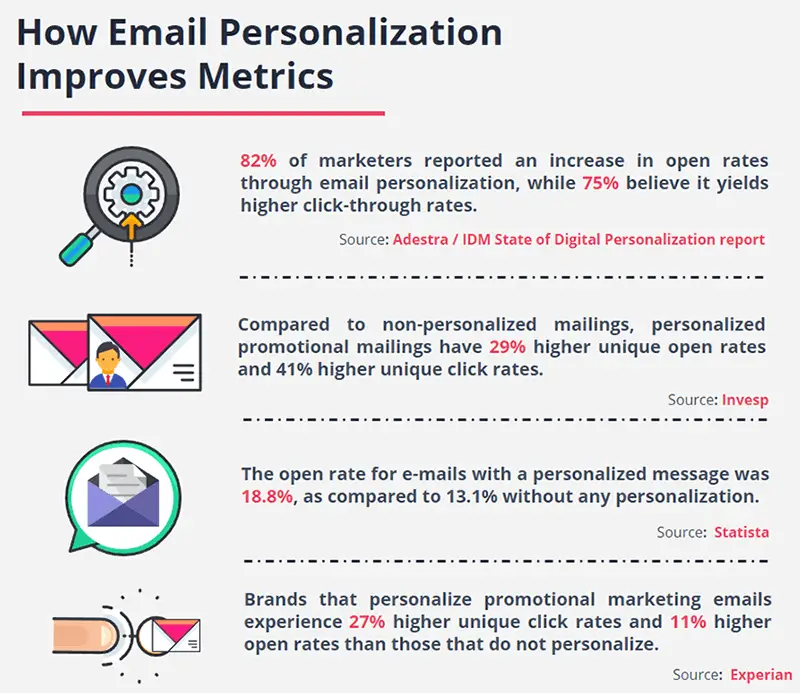
Personalization is a powerful tool, not simply an informal gesture. It increases conversions, click-through rates, and engagement. Personalization improves your email marketing KPIs in measurable ways, so it's not simply a feel-good strategy. achieving observable outcomes that make your email marketing efforts shine. Let’s look at some benefits of personalization:
Increased Open Rates
Subscribers are more likely to read emails that are personalized. Subject lines that are personalized, in particular, capture their interest and persuade them to click. Experian research showed that personalized subject lines may improve open rates by 26%.
Higher Click-Through Rates and Conversions
When you send information that is personalized to the interests and requirements of your readers, they are more likely to engage with your email and take the necessary action. Personalization may increase click-through rates by 14 percent and conversion rates by 10 percent or more.
Improved Customer Relationships
You create trust and build better connections by showing that you understand and care about your subscribers' choices. Customers who feel appreciated are more likely to stay loyal and make repeat purchases.
Reduced Unsubscribe Rates
Unsubscribes are typically the result of generic or irrelevant communications. However, personalization makes it easier to offer information that your audience finds compelling, which lowers the possibility that they will click the dreaded "unsubscribe" button.
Why Personalization Matters for Email Marketing Metrics?
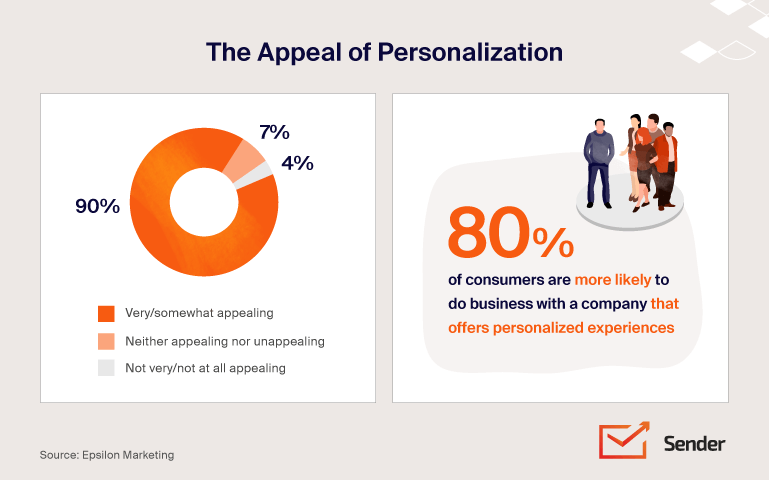
In email marketing, personalization is similar to giving your campaigns energy to help them accelerate toward success. Let's see how it may benefit your campaigns in more detail:
Improved Open Rates
You can stand out in a busy inbox and encourage recipients to open your emails by personalizing the subject line. According to case studies, using personalized subject lines helps companies raise open rates by an average of 50%.
Enhanced Click-Through Rates and Conversions
Emails that are customized for each recipient based on their interests and preferences increase click-through rates and lead to conversions. Personalized CTAs in emails may raise click-through rates by 202%, claims HubSpot.
Boost in Conversion Rates
Your subscribers are more likely to convert when you deliver them items or offers that are relevant to them. When firms provide personalized experiences, 80% of consumers are more likely to make a purchase.
Decreased Unsubscribe Rates
You can make sure that subscribers receive information that is relevant to their needs and interests by sending them personalized emails. As a result, they are less likely to unsubscribe from your list in response to irrelevant or impersonal communications.
Suggested Reading:
How to Implement Personalization in Email Marketing?
Email marketing personalization may significantly increase conversion rates and user engagement. If you decide to use BotPenguin for email marketing customization, the process is simple. This is a step-by-step tutorial to assist you in successfully implementing personalization:
Step 1
Collect and Analyze Customer Data
You must understand your subscribers to personalize your emails. It is essential to gather client information via surveys, sign-up forms, and website analytics. This information may include browsing habits, past purchases, demographics, and more. Examine this data to find trends and information that will guide your customization tactics.
Step 2
Segment Your Email List
Personalized email marketing depends largely on segmentation. Segment your email list into smaller groups according to shared attributes, including geography, age, frequency of purchases, or level of participation. By doing this, you can develop specific advertising campaigns that speak to the particular requirements and tastes of each group of people.
Step 3
Use Dynamic Content
You may customize email content with dynamic material according to the preferences of each segment's unique recipients. Use consumer information to customize your emails' pictures, product recommendations, and offers. It could be personalized product suggestions, special discounts, or information suitable for particular interests.
Step 4
Personalize Subject Lines, Sender Name, and Preheader Text
Creating personalized subject lines is important for capturing the interest of your subscribers. To establish a feeling of validity and a personal connection, use their name, locality, or details about a recent transaction. To further boost open rates, think about personalizing the preheader content and sender name.
Step 5
Test and Refine
Customization is an ongoing effort. Try out several customization strategies to find out which ones your audience responds to the most. You may improve campaign performance and outcomes by A/B testing subject lines, content, and send timings.
The Impact of Personalization on Open Rates in Email Marketing Metrics
Have you ever wondered why someone clicks the "open" button on an email? Customization works similarly to a handshake to get entry. People are compelled to open your email when it directly addresses their needs, interests, and wants. The "Hey, this is just for you!" feeling is what it is. Personalization can make or break your email open rates. Here's how it can have a positive impact:
Personalized Subject Lines
The subject lines are the first impression of your emails. They are more likely to open if you include personalized features like the recipient's name or location. Personalized subject lines may raise open rates by 26%, according to studies. Try out several strategies for customization and track the outcomes.
Sender Name
Open rates are significantly influenced by the sender's name. To boost email open rates, choose a name that people can recognize and trust, such as the company name or a well-known employee. Increasing your sender reputation can help your emails land in the inbox more often.
Preheader Text
The email preview that follows the subject line in the inbox is called the preheader text. Make good use of this area by making it unique. A skillfully written and customized preheader content may draw readers in and enhance your subject line.
Tips for Improving Open Rates through Personalization
Here are some more pointers and best practices for using customization to increase open rates:
- A brief, engaging subject line that is relevant to the email's content is ideal.
- To prevent coming out as overly generic, use customization sparingly and purposefully.
- Try using different emojis in your email subject lines to make them stand out.
- For consistency and engagement, use customization throughout the email, not only in the subject line.
- Keep an eye on your email campaigns and make adjustments depending on open, click-through, and conversion rates.
Suggested Reading:
The Impact of Personalization on Click-Through Rates and Conversions in Email Marketing Metrics
In your email marketing metrics initiatives, personalization may have a big influence on conversions and click-through rates (CTRs). Let's explore how customization affects CTRs:
How Personalization Influences Click-Through Rates?
Emails seem more relevant and individualized when they are customized for each receiver. Higher click-through rates are a direct result of this feeling of relevancy. Subscribers are more likely to interact with and take the intended action from personalized emails since they are more likely to grab their attention.
By utilizing customer data, you can personalize various aspects of your emails, including subject lines, greetings, and content. For instance, addressing subscribers by their first names and recommending products based on their purchase history can significantly increase the likelihood of them clicking through.
Personalized Email Content, Calls to Action, and Landing Pages
To increase click-through rates and conversions, it's crucial to create personalized email content. Tailor your messaging to align with the recipient's preferences, needs, and interests. Use dynamic content to showcase relevant products, promotions, or content based on their past interactions or demographics.
Include personalized calls to action (CTAs) in your emails to direct subscribers towards desired actions. For example, use personalized CTAs based on the recipient's browsing behavior or purchase history. This level of personalization fosters a sense of individualized attention and increases the chances of click-throughs.
Landing pages are another crucial element of your email marketing strategy. Personalized landing pages to match the specific email campaigns and the interests of each subscriber segment. Delivering a cohesive and personalized experience from email to landing page increases the likelihood of conversions.
The Impact of Personalization on Unsubscribe Rates
Personalization can also play a vital role in reducing unsubscribe rates. By sending relevant and targeted emails to the right audience, you can build stronger connections and keep subscribers engaged. Here's how personalization helps decrease unsubscribe rates:
Sending Relevant and Targeted Emails
When subscribers receive emails that align with their interests, needs, and preferences, they are more likely to remain engaged and less likely to unsubscribe. By utilizing customer data and segmenting your email list, you can deliver personalized content that resonates with each segment's unique characteristics.
Personalization extends beyond just addressing subscribers by name. It involves tailoring the email content to match their preferences, previous interactions, and shopping behavior. The key to email engagement is personalization. To maintain subscribers' interest and engagement in your emails, suggest similar products, provide interesting blog posts, and offer unique deals.
Tips to Decrease Unsubscribes Through Personalization
To help you use customization more successfully and lower your unsubscribe rates, try the following recommendation:
- Divide up your email list into sections according to consumer information like demographics, engagement level, or past purchases.
- To customize emails to each recipient's tastes and habits, use dynamic content.
- Give subscribers choices about how often and what kinds of emails they receive.
- To maintain subscribers' interest, send them emails that are encouraged by particular events or behaviors.
- Review and analyze your email stats regularly to find out what your audience finds compelling and modify your customization tactics accordingly.
You may lower unsubscribe rates while developing a loyal subscriber base that interacts with your emails over time by emphasizing customization and providing targeted, useful data.
Conclusion
In closing, customization in email marketing metrics is a game-changer in achieving engagement and conversion rates.
A fascinating experience can be created by combining landing pages, intriguing calls to action, and customized content. This strategy has a possible 202% increase in click-through rates, which not only boosts client connections, and loyalty, and lowers unsubscribe rates, but also has a major financial impact.
The data speaks for itself: customized emails can improve click-through rates by up to 14%, while customized subject lines can increase open rates by an astounding 26%.
Three happy outcomes: higher click-through rates, increased conversions, and fewer farewells. It's three wins in a row!
Adopt customization; a little bit of it can help you create lasting relationships and lead your email campaigns to success. So start crafting personalized emails now.
Suggested Reading:
Frequently Asked Questions (FAQs)
How does personalization impact email marketing metrics?
Personalization positively affects email marketing metrics such as click-through rates, conversion rates, and overall engagement, as it fosters a more targeted and tailored communication approach.
What are the key benefits of integrating personalization in email campaigns?
Integrating personalization in email campaigns enhances customer experience, fosters brand loyalty, boosts customer retention, and drives higher ROI, creating a more effective and efficient marketing strategy.
What are the essential KPIs (Key Performance Indicators) in the email marketing process?
The essential KPIs in the email marketing process include open rates, click-through rates, conversion rates, and the overall return on investment (ROI), reflecting the effectiveness and success of email campaigns.
What are the 4 Ps of email marketing?
The 4 Ps of email marketing is Personalization, Precision, Performance, and Persistence, emphasizing the importance of targeted messaging, data-driven insights, measurable outcomes, and consistent communication to drive success.

